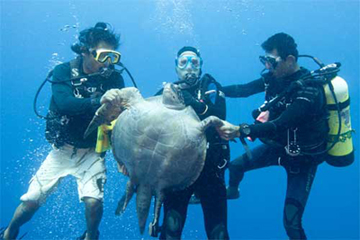My two previous trips to Cocos Island were on the MV Argo, another of the Undersea Hunter fleet, to assist biologists from the U.S.-based Turtle Island Restoration Network and the Costa Rican group PRETOMA (www.pretoma.org ). Our mission was to tag sharks and capture sea turtles at Cocos’ iconic dive sites, which meant I had to override my “programming” of not harassing sea life. Capturing a meterlong turtle to take it to the surface is exciting work. They are such powerful swimmers, we needed two to four divers to hold a turtle and immobilize its flippers, lest it rocket us to the surface in an attempt to escape. Once hauled onto the panga, we transferred the turtle to the Argo, where biologists gave it a quick health check, then weighed, measured and usually equipped it with an acoustic and/or a satellite tag so its movements could be tracked over the following months. Another part of this work was using a speargun- like device to anchor acoustic tags at the base of sharks’ dorsal fins. White-tips are not tagged, as they typically do not leave their small home range, so the larger sharks were the target. No one in the groups I have been diving with has been able to tag a shark.
STRP and PRETOMA have been tagging and tracking turtles for years in an attempt to map their migration routes. Biologists have placed acoustic receivers at six locations around Cocos to record the presence of tagged animals. The final task for divers during the tagging trips is to recover the receivers, download data, replace the batteries and reinstall the receivers in their underwater locations. There are additional receivers near the Galapagos and the Central American mainland to track migration routes so the turtles can be protected. — S.L.
* * * * *
STRP has more turtle-tagging trips at Cocos scheduled for this year and next. There’s room for one male diver on its next trip, May 26 to June 5; everyone else can book for December 9-19, and then in February or July of 2015 ( http://seaturtles.org/article.php?id=1703 ). The price is $6,250 plus airfare.
We did a travel feature last November on one diver’s trip with the New England Aquarium aboard the RV Coral Reef II to tag and collect fish in the Bahamas. You can do the same trip October 18-28 (www.neaq.org/education_and_activities/programs_and_classes/members-only_programs/bahamas_collecting_trips.php ).
The Reef Environmental Education Foundation (REEF) regularly hosts weeklong “field survey” trips that teach divers how to identify fish and collect data for REEF scientists. This year’s trips are clustered in the Caribbean, from Honduras’s Bay Islands June 21-28 to Nevis December 6-13 — but there is a cold-water option at British Columbia’s Hornby Island September 14-18 ( www.reef.org/trips ).
Earthwatch’s goal is to get more people helping with scientific field research and education, so it sponsors expeditions for people with no special skills to become “research assistants” and work alongside scientific pros. They run many expeditions, from swimming with sea turtles in the Bahamas to monitoring endangered manta rays at Australia’s Lady Elliott Island. ( www.earthwatch.org/expedition ).
If you have the time (and money) to go halfway around the globe for a good cause, Blue Ventures, a Britishbased marine conservation nonprofit, is always looking for divers to spend six weeks helping its scientists chart and study the remote southwestern reefs of Madagascar. Rustic, most likely, but one-of-a-kind volunteering experience, absolutely. ( www.blueventures.org )
To get a tax deduction, any volunteer trip must be run by a nonprofit with a 501(c)(3) tax-exempt status (because Blue Ventures is based in the U.K., American divers would be out of luck). The IRS “insists” that the volunteer work must have no “significant” element of personal pleasure or recreation (but, rest assured, there will be no tax man there to look over your shoulder when you order a cold one). This means you’ll need to volunteer about eight hours a day, five days a week to qualify to deduct the airfare or other travel expenses. If you tack on a couple extra days to visit the hotspots, the regulations do not allow you to deduct the airfare. However, you will still be able to get a tax break for the program fee, meals and supplies directly related to your time spent volunteering.


